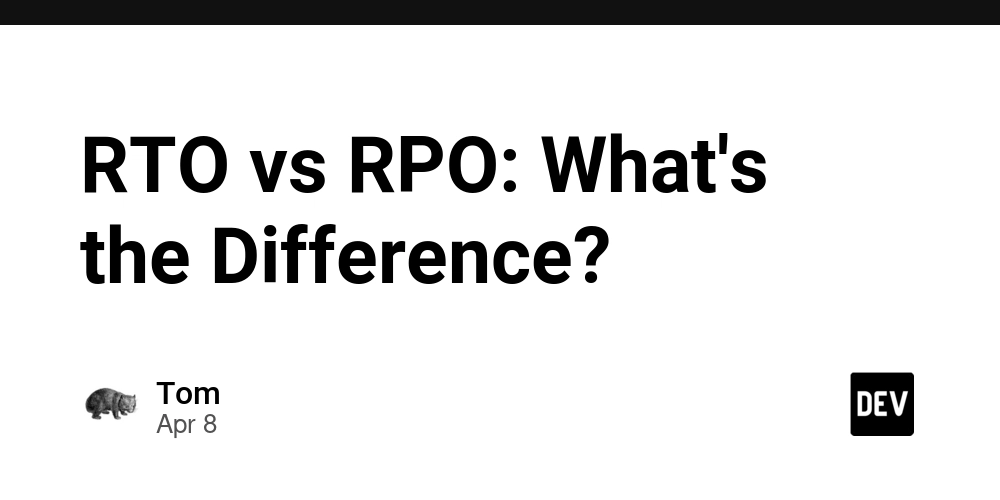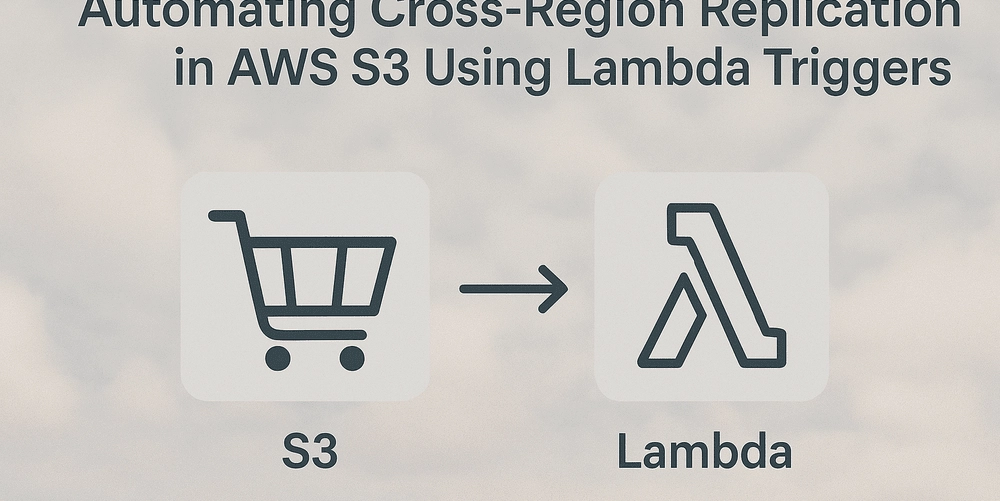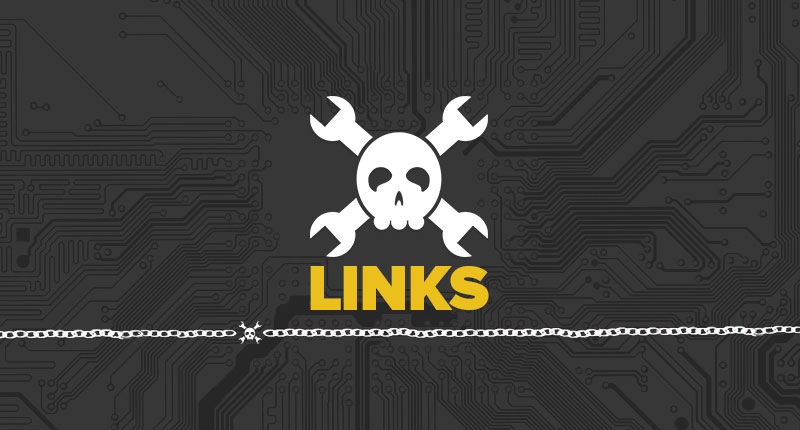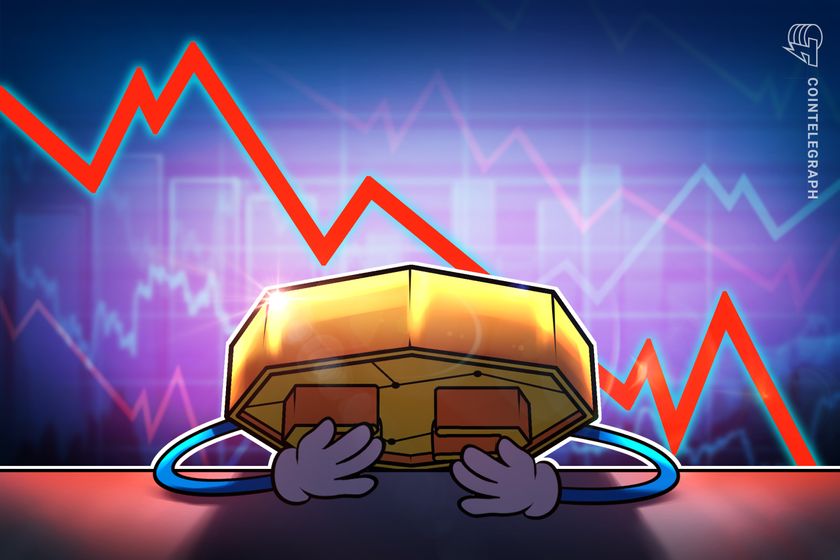RTO vs RPO: What's the Difference?
RTO vs. RPO: Critical Recovery Metrics Every DevOps Engineer Should Know You've just been paged at 3 AM. Production is down. The executive team is bombarding you with one question: "When will we be back online?" Your answer depends entirely on whether you've properly defined and implemented two critical business continuity metrics: RTO and RPO. These aren't just fancy acronyms to throw around in planning meetings. They're the concrete recovery targets that will determine whether this incident is a minor hiccup or a career-defining disaster. Let's break down these recovery objectives differences and how to implement them effectively. RTO: Recovery Time Objective RTO answers a simple question: How long can your business function without this system? RTO = Maximum Acceptable Downtime Think of RTO as a countdown timer that starts the moment your system goes down. Your entire recovery process must complete before this timer hits zero, or you're facing significant business impact. How RTO Works in Practice Here's a real-world RTO implementation: System: Payment Processing API Business Impact: $10,000+ per hour of downtime RTO: 15 minutes Required Components: - Real-time monitoring with 1-minute check intervals - Automated alerting with escalation - Standby systems in alternate regions - Practiced recovery playbooks - Automated failover mechanisms The key insight here is that your infrastructure decisions flow directly from your RTO requirements. A 15-minute RTO demands automation and redundancy, while a 24-hour RTO might be achievable with manual processes. RTO Implementation Checklist To establish effective RTOs: Map business criticality for each system Which systems directly impact revenue? What customer-facing services cannot tolerate downtime? Which internal systems block employee productivity? Define tiered RTOs based on this mapping Tier 1 (Critical): 15 minutes or less Tier 2 (Important): 1-4 hours Tier 3 (Non-critical): 8-24 hours Design recovery processes to meet these targets Tier 1 systems require automation and redundancy Tier 2 systems need clear playbooks and trained responders Tier 3 systems can use more cost-effective, slower recovery approaches Test regularly under realistic conditions Schedule recovery drills that simulate actual outages Time how long recovery takes Identify and fix bottlenecks RPO: Recovery Point Objective While RTO focuses on time, RPO is all about data. It answers: How much data can you afford to lose? RPO = Maximum Acceptable Data Loss Period RPO dictates how frequently you need to back up or replicate your data. It's measured backward from the point of failure. How RPO Works in Practice Here's what RPO looks like in action: System: Customer Database Business Impact: Loss of order history, user preferences, account details RPO: 5 minutes Required Components: - Near-continuous data replication - Transaction log shipping - Point-in-time recovery capability - Backup validation processes - Cross-region data redundancy A tight RPO like 5 minutes requires sophisticated (and often expensive) data protection mechanisms, while a looser RPO of 24 hours might be satisfied with daily backups. RPO Implementation Checklist To establish effective RPOs: Classify data by criticality What data directly impacts revenue if lost? Which records have compliance requirements? What data can be regenerated vs. what is irreplaceable? Set appropriate RPO tiers Tier 1 (Critical): Near-zero data loss (seconds) Tier 2 (Important): Minutes to hours Tier 3 (Non-critical): Daily backups Implement backup/replication strategies based on these tiers Tier 1: Synchronous replication, transaction log shipping Tier 2: Asynchronous replication, frequent backups Tier 3: Daily backups with verification Verify your backups actually work Regularly test restoration processes Validate data integrity and completeness Measure actual recovery times The Critical Differences That Matter in Production Understanding the fundamental recovery objectives differences is essential for building effective business continuity plans: Aspect RTO RPO Core Question "How quickly must we recover?" "How much data can we lose?" Direction Forward-looking from outage Backward-looking from outage Primary Cost Driver Recovery speed Backup frequency Technical Focus System availability Data protection Failure Mode Missing the deadline Data loss These differences drive distinct technical requirements: RTO → Focuses on infrastructure, redundancy, automation RPO → Focuses on backup systems, replication, data integrity Common RTO & RPO Pitfalls After working with dozens of teams implementing RTO and RPO strategies, I've seen these common mistakes: 1. Setting Unrealistic Targets Many organizations set

RTO vs. RPO: Critical Recovery Metrics Every DevOps Engineer Should Know
You've just been paged at 3 AM. Production is down. The executive team is bombarding you with one question: "When will we be back online?"
Your answer depends entirely on whether you've properly defined and implemented two critical business continuity metrics: RTO and RPO.
These aren't just fancy acronyms to throw around in planning meetings. They're the concrete recovery targets that will determine whether this incident is a minor hiccup or a career-defining disaster.
Let's break down these recovery objectives differences and how to implement them effectively.
RTO: Recovery Time Objective
RTO answers a simple question: How long can your business function without this system?
RTO = Maximum Acceptable Downtime
Think of RTO as a countdown timer that starts the moment your system goes down. Your entire recovery process must complete before this timer hits zero, or you're facing significant business impact.
How RTO Works in Practice
Here's a real-world RTO implementation:
System: Payment Processing API
Business Impact: $10,000+ per hour of downtime
RTO: 15 minutes
Required Components:
- Real-time monitoring with 1-minute check intervals
- Automated alerting with escalation
- Standby systems in alternate regions
- Practiced recovery playbooks
- Automated failover mechanisms
The key insight here is that your infrastructure decisions flow directly from your RTO requirements. A 15-minute RTO demands automation and redundancy, while a 24-hour RTO might be achievable with manual processes.
RTO Implementation Checklist
To establish effective RTOs:
- Map business criticality for each system
Which systems directly impact revenue?
What customer-facing services cannot tolerate downtime?
Which internal systems block employee productivity?
- Define tiered RTOs based on this mapping
Tier 1 (Critical): 15 minutes or less
Tier 2 (Important): 1-4 hours
Tier 3 (Non-critical): 8-24 hours
- Design recovery processes to meet these targets
Tier 1 systems require automation and redundancy
Tier 2 systems need clear playbooks and trained responders
Tier 3 systems can use more cost-effective, slower recovery approaches
- Test regularly under realistic conditions
Schedule recovery drills that simulate actual outages
Time how long recovery takes
Identify and fix bottlenecks
RPO: Recovery Point Objective
While RTO focuses on time, RPO is all about data. It answers: How much data can you afford to lose?
RPO = Maximum Acceptable Data Loss Period
RPO dictates how frequently you need to back up or replicate your data. It's measured backward from the point of failure.
How RPO Works in Practice
Here's what RPO looks like in action:
System: Customer Database
Business Impact: Loss of order history, user preferences, account details
RPO: 5 minutes
Required Components:
- Near-continuous data replication
- Transaction log shipping
- Point-in-time recovery capability
- Backup validation processes
- Cross-region data redundancy
A tight RPO like 5 minutes requires sophisticated (and often expensive) data protection mechanisms, while a looser RPO of 24 hours might be satisfied with daily backups.
RPO Implementation Checklist
To establish effective RPOs:
- Classify data by criticality
What data directly impacts revenue if lost?
Which records have compliance requirements?
What data can be regenerated vs. what is irreplaceable?
- Set appropriate RPO tiers
Tier 1 (Critical): Near-zero data loss (seconds)
Tier 2 (Important): Minutes to hours
Tier 3 (Non-critical): Daily backups
- Implement backup/replication strategies based on these tiers
Tier 1: Synchronous replication, transaction log shipping
Tier 2: Asynchronous replication, frequent backups
Tier 3: Daily backups with verification
- Verify your backups actually work
Regularly test restoration processes
Validate data integrity and completeness
Measure actual recovery times
The Critical Differences That Matter in Production
Understanding the fundamental recovery objectives differences is essential for building effective business continuity plans:
| Aspect | RTO | RPO |
| Core Question | "How quickly must we recover?" | "How much data can we lose?" |
| Direction | Forward-looking from outage | Backward-looking from outage |
| Primary Cost Driver | Recovery speed | Backup frequency |
| Technical Focus | System availability | Data protection |
| Failure Mode | Missing the deadline | Data loss |
These differences drive distinct technical requirements:
RTO → Focuses on infrastructure, redundancy, automation
RPO → Focuses on backup systems, replication, data integrity
Common RTO & RPO Pitfalls
After working with dozens of teams implementing RTO and RPO strategies, I've seen these common mistakes:
1. Setting Unrealistic Targets
Many organizations set aggressive RTOs without the infrastructure to match:
"We need 99.999% uptime and zero data loss!"
*Meanwhile, running on a single server with weekly backups*
Your recovery objectives must align with your technical capabilities. This means either investing in the infrastructure needed to meet ambitious targets or adjusting your objectives to match reality.
2. Failing to Test Regularly
Recovery plans are like smoke detectors—they give a false sense of security until you test them.
# A common but dangerous assumption:
$ ls backup_script.sh
backup_script.sh
# What you should be doing:
$ ./test_restore.sh --from-latest-backup --to-staging
Testing restoration from 2023-05-15_02:00...
Verifying data integrity...
Measuring restore time...
Complete: 47 minutes (FAILS RTO requirement of 30 minutes)
Regular, realistic testing is the only way to know if your RTO and RPO targets are achievable.
3. Not Monitoring Your Recovery Capabilities
Your ability to meet recovery objectives depends on continuous monitoring:
What to monitor for RTO:
- Health of standby systems
- Replication lag between primary/secondary
- Automatic failover functionality
- Alert delivery paths
What to monitor for RPO:
- Backup success/failure
- Time between backups vs. RPO target
- Backup storage capacity
- Restoration test results
Without this monitoring, you won't know if your recovery capabilities have degraded until it's too late.
4. One-Size-Fits-All Approach
Not all systems need the same recovery objectives:
Production payment processor: RTO = 5min, RPO = 0min
Internal analytics dashboard: RTO = 4hrs, RPO = 24hrs
Marketing content repository: RTO = 24hrs, RPO = 24hrs
Tailor your RTO and RPO strategies to the specific business impact of each system to optimize costs and efforts.
Implementing Effective Recovery Objectives: A Practical Approach
Here's a step-by-step process for implementing robust recovery objectives:
Step 1: Map System Criticality
Create a comprehensive inventory of your systems and their business impact:
System Name | Revenue Impact | Customer Impact | Internal Impact | Compliance Requirements
------------|----------------|-----------------|-----------------|------------------------
Payment API | $10K/hr | Severe | Moderate | PCI DSS
User Auth | $8K/hr | Severe | Severe | SOC2, GDPR
Analytics | None | None | Moderate | None
Step 2: Define Tiered Objectives
Based on this mapping, establish tiered RTOs and RPOs:
Tier | Systems | RTO Target | RPO Target | Recovery Strategy
-----|---------------|------------|------------|-------------------
1 | Payment, Auth | 15min | 0-5min | Multi-region active-active
2 | Order Mgmt | 1hr | 15min | Warm standby, async replication
3 | Analytics | 8hrs | 24hrs | Daily backups, manual recovery
Step 3: Design Technical Solutions
Implement the infrastructure needed to meet these objectives:
For Tier 1 (15min RTO, 5min RPO):
- Active-active deployment across regions
- Real-time database replication
- Automated health checking and failover
- Comprehensive monitoring with 1min check intervals
For Tier 2 (1hr RTO, 15min RPO):
- Warm standby environments
- Regular data replication (15min intervals)
- Semi-automated recovery procedures
- Monitoring with 5min check intervals
Step 4: Create Recovery Playbooks
Document detailed recovery procedures for each tier:
# Tier 1 System Recovery Playbook
## Automatic Failover (Primary)
- System detects unhealthy primary region
- Traffic automatically routes to secondary region
- Alerts sent to on-call team
- On-call confirms successful failover
## Manual Failover (Backup)
If automatic failover fails:
1. On-call logs into control panel at https://failover.example.com
2. Selects affected system
3. Initiates manual failover
4. Verifies health of secondary region
5. Updates incident status
Step 5: Test and Refine
Implement a regular testing schedule:
Monthly: Tabletop exercises (discussion-based)
Quarterly: Controlled tests in production
- Scheduled during low-traffic periods
- Limited to specific services
- Full rollback capability
Annually: Full disaster recovery simulation
- Tests cross-dependencies
- Involves all teams
- Measures against RTO/RPO targets
Step 6: Continuously Monitor and Improve
Establish monitoring to ensure ongoing recovery readiness:
Daily automated checks:
- Backup completion status
- Replication lag metrics
- Standby system health
- Recovery time estimates
Weekly review:
- Backup validation results
- Changes to system dependencies
- Alerts from monitoring systems
- Improvements to recovery processes
Practical Examples: RTO and RPO in Action
To make these concepts concrete, let's look at how different types of systems implement recovery objectives:
E-commerce Payment Processing
Business impact: Direct revenue loss, customer frustration
RTO: 5 minutes
RPO: Near-zero (continuous transaction logging)
Implementation:
- Active-active deployment across 3 regions
- Real-time transaction replication
- Automated health checks every 30 seconds
- Automatic failover with manual confirmation
- Transaction journaling to prevent data loss
Customer Support Platform
Business impact: Support agent productivity, customer satisfaction
RTO: 1 hour
RPO: 15 minutes
Implementation:
- Primary-secondary deployment
- Database replication with 15-minute lag maximum
- Regular health checks every 5 minutes
- Semi-automated failover procedure
- Transaction logs shipped every 15 minutes
Internal Analytics Platform
Business impact: Delayed decision making, minimal direct revenue impact
RTO: 8 hours
RPO: 24 hours
Implementation:
- Single region deployment with backup capability
- Daily full backups with verification
- Basic health checks every 15 minutes
- Documented manual recovery procedure
- Asynchronous data processing with replay capability
These examples highlight how recovery strategies should align with business impact, creating a cost-effective approach to business continuity.
Conclusion: Bringing It All Together
RTO and RPO aren't just theoretical concepts—they're practical tools that drive real engineering decisions. When implemented correctly, they provide:
Clear recovery expectations for stakeholders
Concrete targets for engineering teams
Justification for infrastructure investments
Framework for testing and validation
The key to success is understanding the fundamental recovery objectives differences and implementing appropriate strategies for each system based on its business criticality.
Remember that these objectives aren't static—they should evolve as your systems and business needs change. Regular testing and refinement are essential parts of maintaining effective business continuity capabilities.
By taking a thoughtful, tiered approach to recovery planning, you can ensure that your most critical systems have the protection they need while optimizing costs for less critical components.
For more detailed guidance on implementing effective RTO and RPO strategies with practical examples and templates, check out our comprehensive guide on business continuity planning.











































































































































































![[The AI Show Episode 143]: ChatGPT Revenue Surge, New AGI Timelines, Amazon’s AI Agent, Claude for Education, Model Context Protocol & LLMs Pass the Turing Test](https://www.marketingaiinstitute.com/hubfs/ep%20143%20cover.png)


























































































































![[DEALS] Microsoft Visual Studio Professional 2022 + The Premium Learn to Code Certification Bundle (97% off) & Other Deals Up To 98% Off](https://www.javacodegeeks.com/wp-content/uploads/2012/12/jcg-logo.jpg)



![From Accountant to Data Engineer with Alyson La [Podcast #168]](https://cdn.hashnode.com/res/hashnode/image/upload/v1744420903260/fae4b593-d653-41eb-b70b-031591aa2f35.png?#)






































































































.png?#)






































































































































![What Google Messages features are rolling out [April 2025]](https://i0.wp.com/9to5google.com/wp-content/uploads/sites/4/2023/12/google-messages-name-cover.png?resize=1200%2C628&quality=82&strip=all&ssl=1)











![iPadOS 19 Will Be More Like macOS [Gurman]](https://www.iclarified.com/images/news/97001/97001/97001-640.jpg)
![Apple TV+ Summer Preview 2025 [Video]](https://www.iclarified.com/images/news/96999/96999/96999-640.jpg)
![Apple Watch SE 2 On Sale for Just $169.97 [Deal]](https://www.iclarified.com/images/news/96996/96996/96996-640.jpg)


































































































































